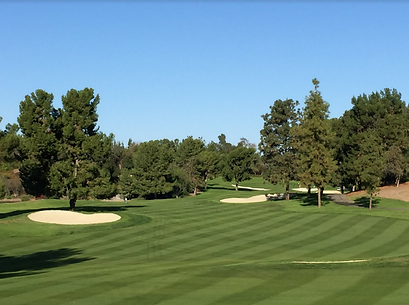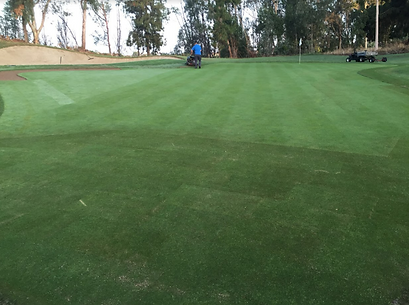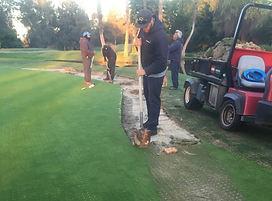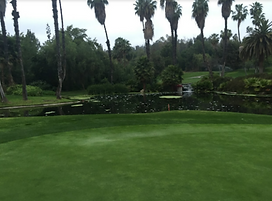Overseeding
Industry Hills Golf Club consists of two championship golf courses that were overseeded wall-to-wall annually, totaling 180 acres of turf: The Eisenhower (Ike) and Zaharias (Babe). The base crop, predominately Tifway 419 had some Kikuyu grass, Poa Annua, and also incorporated Turf Type Tall Fescue under the trees in shaded areas to improve year-round conditions.
-
Goal one: to have a healthy Bermuda base going into overseed.
-
Aerate in the summer, then aggressively verticut all summer long but discontinue in September to allow the Bermuda to recover and regain energy and carbohydrates going into overseed and winter.
-
Six weeks prior to seeding, apply a balanced granular fertilizer. Also, ensure additional nutrient inputs to establish strong roots.
-
Overseed prep:
-
Growth regulators prior to overseed prep.
-
Vertical mow in one direction but not too aggressively.
-
Mow two directions at about 1/3” inch followed by debris cleanup.
-
Apply growth regulators, wetting agents, insecticides, and fungicides, if needed, on the turf mat prior to dropping seed.
-
Overseed with drop spreaders in three directions for optimum coverage and orientation of seed at planting.
-
Skillful watering management up to and beyond establishment.
-


Ike Course #11 Before & After


Ike Course #17 Before & After



Ike Course #10 Before, During, & After

Ike Course #1

Ike Course #8


Ike Course #18

Babe Course #12

Industry Hills Overhead View Before & After (16 days)
Greens Repair & Drainage Improvement
I landed the opportunity to become the Golf Course Superintendent at Industry Hills Golf Club in October of 2016. The previous Superintendent, unfortunately, experienced a chemical misapplication on the cleanup passes of the greens, resulting in permanent damage. Many of the greens were repaired prior to my arrival; however, there were still five greens that had substandard sod work performed and would not stand up to the test of time. Furthermore, there were also many greens that did not drain well; this resulted in yellow wilting turf and a black layer within the soil profile.
All the grass had been used from both nurseries, and the poor-quality sod work was Bentgrass sod laid into a 100% Poa Annua putting surface. The nutrient requirement and water requirement of the two crops were completely opposite, therefore, presenting a challenge in managing. This also presented an aesthetic challenge since the Bentgrass laid within the Poa Annua putting green looked like a cookie-cutter repair job that would not blend in for years. Additionally, when they laid the Bentgrass sod in the green, pure sand was laid down to make the sod level with the existing turf level which caused two issues: 1) It created a laminate layer, restricting long-term or permanent root development. 2) This environment created a situation where the sod would need to be overwatered to stay alive due to lack of organic matter in the sand and lack of root development just mentioned in point one.
A creative approach needed to be taken to correct these issues quickly and permanently. The following methods below spearheaded and rectified the issues with the greens at Industry Hills Golf Club. Consequently, this restored the reputation of the golf club, repaired the relationship between BrightView Golf Maintenance and Pacific Palms Resort, and instilled confidence in my ability with the Director of Golf.
Putting Green Restoration:
-
We constructed two new nurseries with the use of aerification plugs from the greens and Bentgrass seed. Since I started in October during aerification, this project was completed immediately. This process allowed for the establishment of predominantly Poa Annua putting green sod that matched the existing putting green surface.
-
The next step was the removal of the failing Bentgrass sod from the troubled putting greens.
-
Afterward, we cultivated the existing greens mix with a rototiller. Additionally, we removed some of the existing greens sand and mixed it with USGA sand to have a surplus of greens mix in case there was a need to raise the soil underneath the sod being laid. This would prevent us from repeating the same mistake caused before by laying pure sand and creating a laminate layer between the sod and soil profile within the green. If we needed to add sand to low areas, it was greens mix and not pure sand. So commonly, pure sand is placed under sod to level it without considering a homogenous greens or soil mix.
-
The sod was very carefully installed on top of pre-plant fertilizer, tamped, watered, and rolled.
-
Careful nurturing of the sod with walk mowing, handwork, some additional plug work, and careful hand watering allowed for the successful repair of the issued greens at Industry Hills Golf Club.
Drainage Work:
The illustrations below demonstrate how we improved putting green health by lowering dammed collars and installing additional “smile” drains and/or connecting ones capped during construction. The photos of #10 Ike show drastic improvement from the wilted yellow turf that had black layer beneath shown in the before photo to the after photo once the drain was connected. A few other photos demonstrate the addition of drains to improve water movement and the health of the green.


Ike Course #10: Green Before & After

Ike Course #10: Drain Cap


Ike Course #10: Drainage Work

Ike Course #11: Green Before & After

Ike Course #11: Repair Work

Ike Course #8: Drainage Work



Zaharias (Babe) Course: Green Before, During, & After



Zaharias (Babe) Course #3: Repair Work

Zaharias (Babe) Course #1: Drainage
Landscaping
The maintenance contract between BrightView Golf Maintenance at Industry Hills Golf Club at Pacific Palms Resort included the maintenance of three acres of extensive landscaping, lawns, shrubs, palm tree management, and annual flower rotational plantings.


Mulch: Before & After


Woodchips: Before & After


Lawn: Before & After






